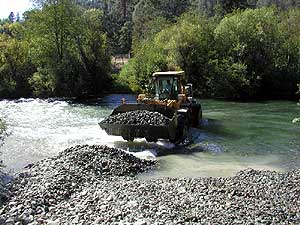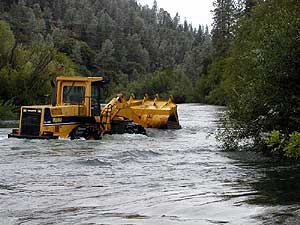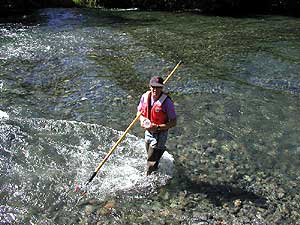Trinity River Gravel: for Now and the Future
by Trinity River Restoration Program Staff
 |
Gravel was placed directly in the
Trinity River by local contractor
Clint Robison
The goal of the Trinity River Restoration Program (TRRP) is to restore a self-sustaining anadromous fishery downstream of Lewiston Dam. Anadromous fish, such as salmon and steelhead, are born in the Trinity River and its tributaries, live most of their lives in salt water, and then return to freshwater again to spawn as adults. The TRRP hopes to assist in the recovery in these species by restoring to the Trinity River the attributes of a healthy alluvial (gravel & cobble) river. Historically gravel moved down the river, much like on a conveyor belt, each year with high-flows. With construction of the Trinity River and Lewiston dams, river flows were drastically reduced and access to gravel upstream of the dams was cut off. River gravel for use by creatures of all life-stages was either washed downstream or locked in the river banks, held immobile by abundant vegetation. Now the river lacks the abundant and clean gravel needed to form complex spawning and rearing habitat for fish.
Gravel also scours riverside vegetation during high flows, maintaining diverse floodplain habitats. In September of this year, the TRRP took a first step towards correcting this problem. Approximately 3,000 tons of local Trinity River coarse sediment (1- 6 inch clean gravel) was placed directly into the river upstream of the old Lewiston Bridge in Lewiston.
 |
Gravel was spread to an approximate
in-river depth of one or two feet
Several past Trinity River gravel introduction efforts have relied on placement of gravel along the riverís edge. These stock piles require high flows (which are unreliable in timing) to move the material into the active river channel and downstream This yearís project used a front-end loader to spread material approximately 2 ft deep over a little more than Ĺ acre of river bed. Concrete Aggregate Products, Inc. performed the work over a two week period. Turbidity measurements were taken every two hours to determine project impacts to water quality, meet Water Quality Control Board permitting requirements, and to ensure that these were minimal. Surveys were made to ensure that gravel was installed to an elevation that would be usable for fish and passable by recreationists during decreased fall flows. For long-term monitoring, at least two pre and post implementation comparisons will be made. Fish use will be compared before and after the project and several surveyed river cross sections will allow quantification of changes in channel form over time.
In the future, the TRRP intends to re-establish a man-made equilibrium of gravel supply below Lewiston Dam. This will be carried out under the guidance of our Coarse Sediment Management Plan (CSMP) which will outline methods, locations, and amounts of coarse sediment (gravel) to be added to the Trinity River based on known annual flow regimes and reach specific gravel needs. Since large amounts of gravel, up to 100,000 tons, are presently prescribed by the Trinity River Flow Evaluation Study for very wet years, this first project provided important insights into regulatory and physical challenges which our program will encounter with larger proposed coarse sediment introductions. An adequate number of trucks will need to be available, larger areas of vegetation may need to be cleared to allow better river access, traffic routes will need to be identified and marked, and actual movement of the gravel into the river will have to be done more quickly.
 |
Turbidity samples, to determine
project impacts to water clarity,
were required every two hours
In addition, the same methods used to protect the environment in smaller jobs may not be adequate in larger and long-term operations. For example, concerns about short-term degradation of water clarity and potential for chemical contamination were addressed this year as gravels were thoroughly washed before addition. This may not be practical on a very large scale. What is more, monitoring of near-project water clarity (turbidity) indicated that, at a minimum, some short-term turbidity impacts were inevitable with gravel additions during clear summer periods. Perhaps the CSMP will need to recommend winter/spring introduction of gravels when flows and turbidity are both high.
In any case, the TRRP will work with environmental protection agencies to outline long-term procedures which allow such beneficial actions to take place. In the area of gravel management, the only long-term assurance seems to be the need for more gravel. Answers will probably only be won through experience and continued coordination with interested landowners and regulators.
This issue of the Conservation Almanac is being funded in part by grants from the
Trinity River Restoration Program, Trinity County Title III, California
Department of Fish and Game, and Sacramento Regional Foundation
|


